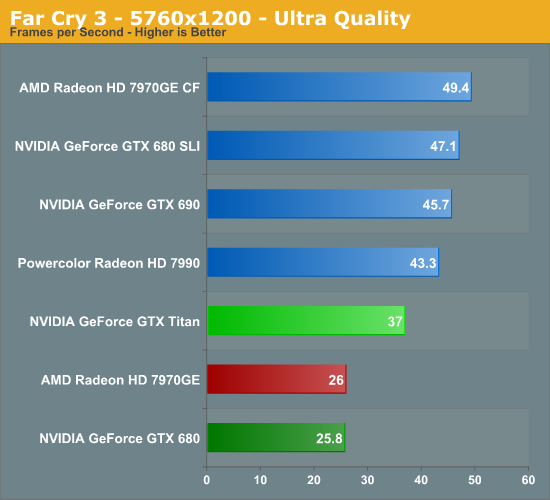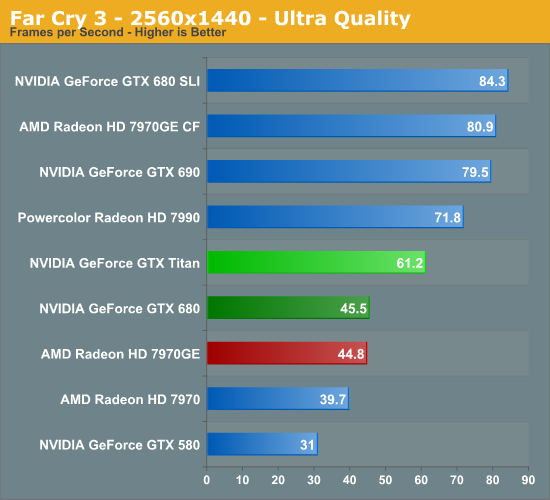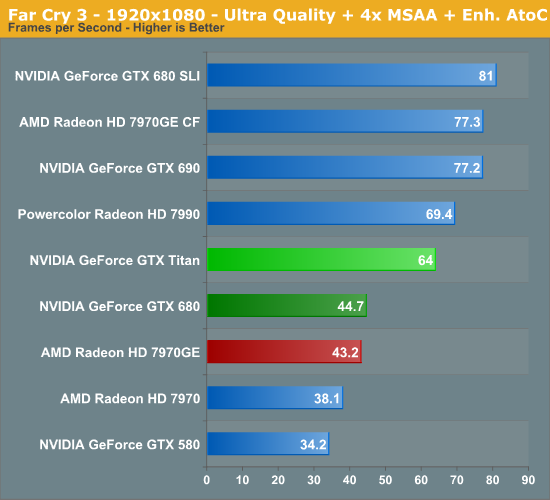NVIDIA’s GeForce GTX Titan Review, Part 2: Titan's Performance Unveiled
by Ryan Smith & Rahul Garg on February 21, 2013 9:00 AM ESTFar Cry 3
The final new game added to the latest rendition of our benchmark suite is Far Cry 3, Ubisoft’s recently released island-jungle action game. A lot like our other jungle game Crysis, Far Cry 3 can be quite tough on GPUs, especially with MSAA and improved alpha-to-coverage checking thrown into the mix. On the other hand it’s still a bit of a pig on the CPU side, and seemingly inexplicably we’ve found that it doesn’t play well with HyperThreading on our testbed, making this the only game we’ve ever had to disable HT for to maximize our framerates.



For the 7970GE and GTX 680, FC3 at 2560 was already a very close match. Or put another way, with the 7970GE and GTX 680 tied up with each other, Titan is free to clear the both of them by approximately 35% each at 2560. This is enough to launch Titan past the 60fps mark, the first for any single-GPU card.
As for our other resolutions, it’s interesting to note that the gains at both 5760 and 1920 with MSAA are actually greater than at 2560. As we mentioned before Far Cry is somewhat demanding on the CPU side of things, so Titan may not be fully stretching out at 2560. In which case the performance gains due to Titan would be closer to 45-50%.
Moving on to our multi-GPU cards, this is something of a mixed bag. Titan isn’t close to winning, but GTX 690 wins by under 30%, and 7990 by just 17%. This is despite the fact that SLI/CF scaling is as strong as it is. At the same time Far Cry 3 is a good contemporary reminder of just what Titan can excel at: had Titan been out in 2012, it would have been doing roughly this well while NVIDIA would have still been hammering out their SLI profiles for this game. Multi-GPU cards are powerful, but they are forever reliant on waiting for profiles to unlock their capabilities.










337 Comments
View All Comments
CeriseCogburn - Tuesday, February 26, 2013 - link
Yes, and this is the core situation the radical chizow and others like him have chosen to completely ignore.Ivy is 22nm and only 14nm now appears to be possible as approx. 30 atoms are channel widths, with electromigration/plasma leakage hits a critical stage.
So the slowdown has already occurred, Moore's law is broken (decelleration has been occurring for a long time) , and the reality is near present with the "largest possible" die at Titan's node.
The number of atoms across in the "electric wire channel" and insulator sides width is down to countable on fingers and toes and it appears there's nearly no place to go.
That's why we keep hearing about quantum computing dreams, and why shrinkage steps have been less beneficial toward this wall.
So, expect the crybabies to be taking up a few notches more into an ever higher pitch the next couple of releases. It's coming, or rather it's here.
vanwazltoff - Friday, February 22, 2013 - link
the 690, 680 and 7970 have had almost a year to brew and improve with driver updates, i suspect that after a few drivers and an overclock titan will creep up on a 690 and will probably see a price deduction after a few months. dont clock out yet, just think what this could mean for 700 and 800 series cards, its obvious nvidia can deliverinitialised - Friday, February 22, 2013 - link
When are you guys going to start posting 4K performance for high end graphics?iceman-sven - Friday, February 22, 2013 - link
I am also wondering. Anandtech need to buy the Sharp PN-K321 fast. I will upgrade from my 2560x1600 to 4k in the next 12 months.I hope Anandtech does a rerun of some benchmarks with 4k and Titan SLI configurations. I am planning to buy 2 Titan for this.
Ryan Smith - Monday, February 25, 2013 - link
When someone releases a suitable desktop monitor and we can acquire it on a long-term basis. Something like Sharp's 32-incher is the right resolution, but it really pushes the boundary for what can be called a "desktop" monitor.ElminsterTCOM - Friday, February 22, 2013 - link
I was wondering if you could pop this card into a Mac Pro and let us know if it is compatible? This would be a great card for 3D modeling!Saxie81 - Friday, February 22, 2013 - link
I'm wondering why the other websites that give reviews, benchmarks etc, have missed the mark with this card. Everywhere I look, they are posting nothing but game benchmarks, this is why I keep coming to Anandtech. This clearly is meant for more than that. I'm looking @ it for gaming and 3d rendering. I would have loved to have seen maybe Rendering times on a simple image in Blender etc, but the compute benchmarks gives a pretty good indication of what the Titan is capable of. Great article as always, Ryan, and welcome Rahul!Zoeff - Friday, February 22, 2013 - link
Looking at the Crysis 1080p at highest settings benchmark. I guess they're the wrong way around? :)Ryan Smith - Monday, February 25, 2013 - link
Do'h. Fixed.realneil - Friday, February 22, 2013 - link
Seems like whenever `anyone` releases the ~newest/best~ video card, they always price it at a grand. So this isn't surprising to me at all. How much were the Matrix cards from ASUS when they were new?I just can't see spending that much for it though. A pair of 680s or 7970s would get the job done for me.